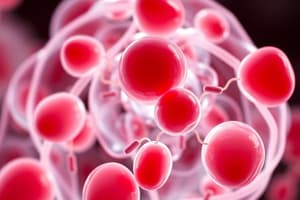Podcast
Questions and Answers
Which of the following is the primary function of the cristae found within mitochondria?
Which of the following is the primary function of the cristae found within mitochondria?
- To facilitate the movement of molecules between the intermembrane space and the matrix.
- To increase the surface area available for ATP production. (correct)
- To store mitochondrial DNA (mtDNA).
- To regulate the permeability of the outer mitochondrial membrane.
During cellular respiration, the electron transport chain (ETC) plays a vital role. What is the direct result of the ETC's function in the inner mitochondrial membrane?
During cellular respiration, the electron transport chain (ETC) plays a vital role. What is the direct result of the ETC's function in the inner mitochondrial membrane?
- Direct synthesis of ATP molecules.
- Formation of a proton gradient that drives ATP synthesis. (correct)
- Conversion of carbon dioxide into oxygen.
- Breakdown of glucose into pyruvate.
Mitochondrial DNA (mtDNA) differs from nuclear DNA in several ways. Which of the following is a characteristic of mtDNA?
Mitochondrial DNA (mtDNA) differs from nuclear DNA in several ways. Which of the following is a characteristic of mtDNA?
- It undergoes recombination during sexual reproduction.
- It is linear and complexed with histones.
- It is a small, circular molecule inherited maternally. (correct)
- It encodes for all the proteins required for mitochondrial function.
Besides energy production, mitochondria play a crucial role in several other cellular processes. Which of the following is a function of mitochondria?
Besides energy production, mitochondria play a crucial role in several other cellular processes. Which of the following is a function of mitochondria?
Which stage of cellular respiration directly involves the intermembrane space of the mitochondria?
Which stage of cellular respiration directly involves the intermembrane space of the mitochondria?
A researcher is studying a cell line with a mutation affecting the function of ATP synthase in the mitochondria. What direct effect would this mutation likely have on the cell?
A researcher is studying a cell line with a mutation affecting the function of ATP synthase in the mitochondria. What direct effect would this mutation likely have on the cell?
A patient is diagnosed with a mitochondrial disorder due to a mutation in their mtDNA. Considering the characteristics of mtDNA, from whom did the patient most likely inherit this mutation?
A patient is diagnosed with a mitochondrial disorder due to a mutation in their mtDNA. Considering the characteristics of mtDNA, from whom did the patient most likely inherit this mutation?
Dysfunction of mitochondria has been implicated in numerous diseases. Which of the following conditions is associated with mitochondrial dysfunction?
Dysfunction of mitochondria has been implicated in numerous diseases. Which of the following conditions is associated with mitochondrial dysfunction?
Flashcards
Mitochondria
Mitochondria
Organelles in eukaryotic cells generating ATP, the energy currency.
ATP
ATP
Adenosine triphosphate, the main energy carrier in cells.
Double membrane
Double membrane
Mitochondria have an outer smooth membrane and an inner folded membrane.
Cristae
Cristae
Signup and view all the flashcards
Cellular respiration
Cellular respiration
Signup and view all the flashcards
mtDNA
mtDNA
Signup and view all the flashcards
Mitochondrial dysfunction
Mitochondrial dysfunction
Signup and view all the flashcards
Importance of Mitochondria
Importance of Mitochondria
Signup and view all the flashcards
Study Notes
Introduction to Mitochondria
- Mitochondria are organelles found in most eukaryotic cells.
- They are responsible for generating most of the cell's supply of adenosine triphosphate (ATP).
- ATP is the main energy currency of the cell.
- They are often referred to as the "powerhouses" of the cell due to their crucial role in energy production.
Structure of Mitochondria
- Mitochondria have a double membrane.
- The outer membrane is smooth and permeable to various molecules.
- The inner membrane is highly folded into cristae.
- These folds increase the surface area for ATP production.
- The space between the inner and outer membranes is called the intermembrane space.
- The space enclosed by the inner membrane is called the mitochondrial matrix.
- The mitochondrial matrix contains mitochondrial DNA (mtDNA), ribosomes, and enzymes involved in various metabolic processes.
Mitochondrial Function - Cellular Respiration
- Mitochondria are the site of cellular respiration.
- Cellular respiration is a process where energy is released from glucose and other molecules, creating ATP.
- The process involves several stages including glycolysis, the citric acid cycle (Krebs cycle), and oxidative phosphorylation.
- Oxidative phosphorylation, which occurs in the inner mitochondrial membrane, is the major source of ATP.
- Electron transport chain (ETC) is a crucial part of oxidative phosphorylation.
- The ETC transfers electrons from electron carriers to oxygen, creating a proton gradient across the inner membrane.
- This gradient fuels ATP synthesis by ATP synthase.
Mitochondrial DNA (mtDNA)
- Mitochondria contain their own DNA (mtDNA).
- mtDNA is a small, circular molecule.
- It differs from nuclear DNA in its structure and replication.
- mtDNA encodes for some of the proteins involved in mitochondrial function.
- mtDNA is inherited maternally.
- Mutations in mtDNA can cause various diseases.
Importance of Mitochondria
- Mitochondria are essential for various cellular processes including:
- Energy production for cellular activities
- Apoptosis (programmed cell death)
- Calcium homeostasis
- Heat production
- Steroid hormone synthesis.
Mitochondrial Dysfunction
- Dysfunction in mitochondria can lead to various health problems.
- These problems can range from mild to severe.
- Examples of mitochondrial disorders include:
- Muscular dystrophy
- Neurological disorders
- Diabetes
- Heart disease.
Studying That Suits You
Use AI to generate personalized quizzes and flashcards to suit your learning preferences.




